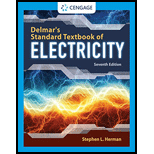
Delmar's Standard Textbook Of Electricity
7th Edition
ISBN: 9781337900348
Author: Stephen L. Herman
Publisher: Cengage Learning
expand_more
expand_more
format_list_bulleted
Concept explainers
Textbook Question
Chapter 11, Problem 6RQ
What is used to hold a sulfate ion together?
Expert Solution & Answer
Trending nowThis is a popular solution!

Students have asked these similar questions
please answer it handwritten , thanks! will give thumbs up
EXAMPLE 6.3
Suppose the Fourier transform of a pulse is as follows:
(1-a)
Ть.
2Ть
H(f) = <
α
(To) (-Tof+
1 +a
(1-a)
(1+α)
·<|f|≤·
2
2ть
2Ть
(1+α)
0,
<\f\
2Ть
where 0≤a≤1. Show that this pulse in both time and frequency domains satisfies the Nyquist
criterion.
In matlab
Chapter 11 Solutions
Delmar's Standard Textbook Of Electricity
Ch. 11 - 1. Conduction in a liquid depends on the movement...Ch. 11 - What is a negative ion?Ch. 11 - 3. What is a positive ion?
Ch. 11 - Name three basic substances that can be used to...Ch. 11 - What is an electrolyte?Ch. 11 - 6. What is used to hold a sulfate ion together?
Ch. 11 - What is the negative terminal of a power source...Ch. 11 - Prob. 8RQCh. 11 - What determines the thickness of the coating...Ch. 11 - What is electrolysis?
Knowledge Booster
Learn more about
Need a deep-dive on the concept behind this application? Look no further. Learn more about this topic, electrical-engineering and related others by exploring similar questions and additional content below.Similar questions
- not use ai pleasearrow_forwardIn matlabarrow_forwardEXAMPLE 4.4 In a binary symmetric communication (BSC) channel, the input bits transmitted over the channel are either 0 or 1 with probabilities p and 1-p, respectively. Due to channel noise, errors are made. As shown in Figure 4.4, the channel is assumed to be symmetric, which means the probability of receiving 1 when 0 is transmitted is the same as the probability of receiving 0 when 1 is transmit- ted. The conditional probabilities of error are assumed to be each e. Determine the average prob- ability of error, also known as the bit error rate, as well as the a posteriori probabilities.arrow_forward
- What is the bandwidth requirement in Hz for baseband binary transmission at 64 kbps, if the roll-off factor is 0.25?arrow_forwardEXAMPLE 6.4 Suppose the roll-off factor is 25% and the bandwidth of a baseband transmission system satisfying the Nyquist criterion is 30 kHz. Determine the bit rate. Solution 1+α 1arrow_forwardEXAMPLE 4.9 In a communication system, the noise level is modeled as a Gaussian random variable with m=0 and ² = 0.0001. Determine P(X > 0.01) and P(-0.04 ≤x≤ 0.05). 3arrow_forward
- Suppose the random variable X is uniformly distributed between 0 and 1 with probability 0.25, takes on the value of 1 with probability p, and is uniformly distributed between 1 and 2 with probability 0.5. Determine p as well as the pdf and cdf of the random variable Xarrow_forwardconstants: A (medium) single phase transmission line 100 km long has the following Resistance/km = 0.25 2; Susceptance/km = 14 × 10 siemen; Reactance/km = 0.8 Receiving end line voltage = 66,000 V Assuming that the total capacitance of the line is localised at the receiving end alone, determine (i) the sending end current (ii) the sending end voltage (iii) regulation and (iv) supply power factor. The line is delivering 15,000 kW at 0.8 power factor lagging. Draw the phasor diagram to illustrate your calculations.arrow_forwardFor the power system given below, the voltage at bus 2 is kept at 1.03 pu. The maximum power can be delivered by G2 is 35 MW. Obtain the load flow solution. Take the base power 100 MVA. V₁ = 1.0520 G₁ 0.02+j0.06 G2 V2=1.03 P2 = 35 MW 0.08+j0.24 SL2 20+j50 MVA SL3 60+j25 MVA 0.06+j0.018arrow_forward
- General Directions: Read the questions carefully and answer (3*10=30marks) 1. Design a summing amplifier by choosing appropriate values of resistors an so that the output is 5 times the sum of the input voltages. (you are free to use any number of inputs, the type of op-amp, any value of resistors) 2. Derive the equation for the closed loop gain of the inverting and non-inverting Amplifier using appropriate circuit diagrams. 3. Determine the values read by the measuring devices using appropriate formulae www Voc +8V R₁ 33 k Rc 2.2 k ww WWW Poc 200 R₁₂ RE 10 kn 1.0 knarrow_forward十 : + B 日 العنوان I need a detailed drawing with explanation ややハメPV+96252 4 Project Homework: Create a simulation for a tank when the flowrate inside and outside the tank must range between 0 and 10 lit/s: 1) The level should be controlled within a range between more than zero to 1000 lit. 2) An alarm must be launched when the level is out of range (less than 100 and more than 900 lit). 3) When the capacity reaches to the maximum the motor turns OFF. area=A Qout -20 solve in lab view X9.01 *175*1arrow_forwardProject Homework: Create a simulation for a tank when the flowrate inside and outside the tank must range between 0 and 10 lit/s: 1) The level should be controlled within a range between more than zero to 1000 lit. 2) An alarm must be launched when the level is out of range (less than 100 and more than 900 lit). 3) When the capacity reaches to the maximum the motor turns OFF. Qin h C Qout area=A solve in lab viewarrow_forward
arrow_back_ios
SEE MORE QUESTIONS
arrow_forward_ios
Recommended textbooks for you
 Delmar's Standard Textbook Of ElectricityElectrical EngineeringISBN:9781337900348Author:Stephen L. HermanPublisher:Cengage Learning
Delmar's Standard Textbook Of ElectricityElectrical EngineeringISBN:9781337900348Author:Stephen L. HermanPublisher:Cengage Learning Electricity for Refrigeration, Heating, and Air C...Mechanical EngineeringISBN:9781337399128Author:Russell E. SmithPublisher:Cengage Learning
Electricity for Refrigeration, Heating, and Air C...Mechanical EngineeringISBN:9781337399128Author:Russell E. SmithPublisher:Cengage Learning

Delmar's Standard Textbook Of Electricity
Electrical Engineering
ISBN:9781337900348
Author:Stephen L. Herman
Publisher:Cengage Learning

Electricity for Refrigeration, Heating, and Air C...
Mechanical Engineering
ISBN:9781337399128
Author:Russell E. Smith
Publisher:Cengage Learning
Conductivity and Semiconductors; Author: Professor Dave Explains;https://www.youtube.com/watch?v=5zz6LlDVRl0;License: Standard Youtube License